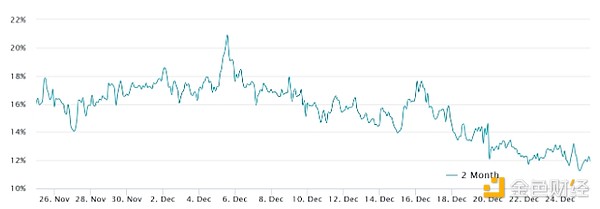
Author: Marcel Pechman, CoinTelegraph; Compiled by: Deng Tong, Golden Finance
Bitcoin has risen 6.5% since the low of $92,458 on December 23, but failed to break through the resistance of $98,000 Bit. After hitting an all-time high of $108,275 on December 17 last year, the stock market pulled back sharply by 14.5% as traders regained confidence.
Bitcoin derivatives maintain a neutral to bullish stance, indicating that violent price fluctuations have not significantly affected market sentiment. This position supports the possibility that gold prices will continue to rise above $105,000.
Bitcoin 2-month futures annualized premium. Source: Laevitas.ch
Bitcoin futures monthly contracts are trading 12% higher than the regular spot market. This indicates strong demand for leveraged long (buy) positions. Typically, a 5% to 10% premium is considered neutral as the seller factors in the extended settlement period when pricing.
Bitcoin 1-Month Options 25% Delta Bias (Puts). Source: Laevitas.ch
Bitcoin put (sell) options are trading at a 2% discount compared to equivalent call (buy) options, in line with trends over the past two weeks. When whales and market makers anticipate a possible pullback, this indicator typically exceeds 6%, reflecting put premium.
A recent recovery in traditional financial markets also pushed Bitcoin above $98,000, as the S&P 500 erased its monthly losses on December 24. In addition, the yield on the 10-year U.S. Treasury note climbed to 4.59% from 4.23% two weeks ago, indicating that investors are demanding higher returns from holding debt.
Recent increases in U.S. Treasury yields typically reflect expectations of higher inflation or rising debt, which can dilute the value of current bond holdings. In contrast, when central banks are forced to stimulate the economy by injecting liquidity, scarce assets such as stocks and Bitcoin tend to perform well.
Amid economic uncertainty, Bitcoin faces stagnation concernsBitcoin’s upside remains limited as investors worry about the risk of global economic stagnation. In this case, predicting the full impact on stock markets and real estate assets is challenging. Currently, Bitcoin’s correlation with the S&P 500 is relatively high at 64%.
The Fed has scaled back its expectations for rate cuts and now says it will cut rates just twice in 2025, compared with four previously expected. This adjustment reduces the short-term risk of declining corporate profits and potential problems with real estate financing.
To assess market sentiment, analyze Bitcoin’sThe margin market is critical. Unlike derivatives contracts, which require buyers and sellers, margin markets allow traders to borrow stablecoins to buy spot Bitcoin or borrow Bitcoin to establish short positions, betting that the price will fall.
OKX’s Bitcoin margin long-short ratio. Source: OKX
OKX’s Bitcoin long to short margin ratio is currently 25x, which favors long (buy) positions. Historically, excessive confidence has pushed this ratio above 40x, while levels below 5x are generally considered bearish.
Both the Bitcoin derivatives and margin markets are showing bullish momentum, despite record outflows from BlackRock’s iShares Bitcoin Trust ETF (IBIT) on December 24. Furthermore, the resilience shown in the retest of $92,458 levels on December 23 has bolstered optimism that Bitcoin has the potential to reach $105,000 and beyond.












